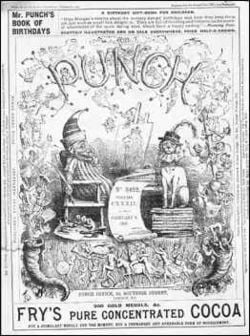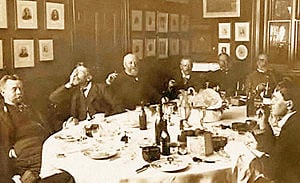Difference between revisions of "Punch (magazine)" - New World Encyclopedia
m |
|||
| Line 5: | Line 5: | ||
[[Image:Punch.jpg|thumb|250 px|right| Punch magazine cover, 1867]] | [[Image:Punch.jpg|thumb|250 px|right| Punch magazine cover, 1867]] | ||
| − | '''''Punch''''' was a [[Great Britain|British]] weekly [[magazine]] of [[humor]] and [[satire]] published from 1841 to 1992 and from 1996 to 2002. | + | '''''Punch''''' was a [[Great Britain|British]] weekly [[magazine]] of [[humor]] and [[satire]] published from 1841 to 1992 and from 1996 to 2002. At the pinnacle of its popularity, ''Punch'' was seen as the exemplar in its field. It featured a number of famous British artists and writers. it was resurrected in 1996 by Mohammed Al Fayed, who believed it to be a British institution. |
==History== | ==History== | ||
| + | [[Image:PunchMagazineMeeting.jpg|left|thumb|300px|Editorial meeting of ''Punch'' magazine in the late nineteenth century.]] | ||
| + | ''Punch'' was founded in July 17 1841 by [[Henry Mayhew]] and engraver [[Ebenezer Landells]]. Punch is thought to be a truncation of ''Punchinello'', from the Neapolitan dialectal "polecenella" meaning a young turkey cock, the hooked bill of which resembles the hooked nose of Punch's mask in the Commedia del Arte.<ref>[http://www.victorianweb.org/periodicals/punch/pva44.html Punch, or the London Charivari (1841-1992) — A British Institution] VictorianWeb. Retrieved February 10, 2007.</ref> | ||
| + | |||
| + | At its founding it was jointly edited by Mayhew and [[Mark Lemon]]. Initially it was subtitled ''The London Charivari'', this being a reference to a satirical humor magazine published in [[France]] under the title ''[[Le Charivari]]''. Reflecting their satiric and humorous intent, the two editors took for their name and masthead the anarchic glove [[puppet]], [[Punch and Judy|Mr. Punch]]; the name also referred to a joke made early on about one of the magazine's first editors, Lemon, that "[[Punch (drink)|punch]] is nothing without [[lemon]]." Mayhew ceased to be joint editor in 1842 and became 'suggestor in chief' until he severed his connection in 1845. ''Punch'' was responsible for the modern use of the word '[[cartoon]]' to refer to a comic drawing. The illustrator [[Archibald Henning]] designed the cover of the magazine's first issues. A drawing by [[Richard Doyle (illustrator)|Richard Doyle]] featuring Punch and his dog Toby was used as the magazine's cover from its inception until 1956, but Doyle's design became the magazine's masthead. Punch and Toby were traditionally still used somewhere on the cover though.<ref>[http://concise.britannica.com/ebc/article-9376146/Punch Punch] Britannica Concise. Retrieved February 10, 2007.</ref> | ||
| − | |||
| − | |||
During the late 19th century ''Punch'' became notorious for regularly publishing anti-Irish jokes. | During the late 19th century ''Punch'' became notorious for regularly publishing anti-Irish jokes. | ||
| − | Circulation peaked during the 1940s when it reached 175,000, but slowly declined over the years, until the magazine was forced to close in 1992 after 150 years of publication. | + | During its history, ''Punch'' featured a number of notable artists and writers in its pages. These include the cartoonists [[John Tenniel]] and [[George du Maurier]], and the writers [[William Makepeace Thackeray]], [[Sylvia Plath]], [[W. Somerset Maugham]], [[Kingsley Amis]], [[A. A. Milne]], and [[P.G. Wodehouse]]. |
| + | |||
| + | Circulation peaked during the 1940s when it reached 175,000, but slowly declined over the years, until the magazine was forced to close in 1992 after 150 years of publication. During its existence, ''Punch'' was considered to be the king of humor magazines and was not seriously challenged in the genre. It reached such a level of fame for its audacious satire and employing some of the brightest stars in art and literature. | ||
== 1996 resurrection == | == 1996 resurrection == | ||
Revision as of 03:56, 11 February 2007
Punch was a British weekly magazine of humor and satire published from 1841 to 1992 and from 1996 to 2002. At the pinnacle of its popularity, Punch was seen as the exemplar in its field. It featured a number of famous British artists and writers. it was resurrected in 1996 by Mohammed Al Fayed, who believed it to be a British institution.
History
Punch was founded in July 17 1841 by Henry Mayhew and engraver Ebenezer Landells. Punch is thought to be a truncation of Punchinello, from the Neapolitan dialectal "polecenella" meaning a young turkey cock, the hooked bill of which resembles the hooked nose of Punch's mask in the Commedia del Arte.[1]
At its founding it was jointly edited by Mayhew and Mark Lemon. Initially it was subtitled The London Charivari, this being a reference to a satirical humor magazine published in France under the title Le Charivari. Reflecting their satiric and humorous intent, the two editors took for their name and masthead the anarchic glove puppet, Mr. Punch; the name also referred to a joke made early on about one of the magazine's first editors, Lemon, that "punch is nothing without lemon." Mayhew ceased to be joint editor in 1842 and became 'suggestor in chief' until he severed his connection in 1845. Punch was responsible for the modern use of the word 'cartoon' to refer to a comic drawing. The illustrator Archibald Henning designed the cover of the magazine's first issues. A drawing by Richard Doyle featuring Punch and his dog Toby was used as the magazine's cover from its inception until 1956, but Doyle's design became the magazine's masthead. Punch and Toby were traditionally still used somewhere on the cover though.[2]
During the late 19th century Punch became notorious for regularly publishing anti-Irish jokes.
During its history, Punch featured a number of notable artists and writers in its pages. These include the cartoonists John Tenniel and George du Maurier, and the writers William Makepeace Thackeray, Sylvia Plath, W. Somerset Maugham, Kingsley Amis, A. A. Milne, and P.G. Wodehouse.
Circulation peaked during the 1940s when it reached 175,000, but slowly declined over the years, until the magazine was forced to close in 1992 after 150 years of publication. During its existence, Punch was considered to be the king of humor magazines and was not seriously challenged in the genre. It reached such a level of fame for its audacious satire and employing some of the brightest stars in art and literature.
1996 resurrection
In early 1996, the Egyptian businessman Mohamed Fayed bought the rights to the name, and it was re-launched later that year. It was reported that the magazine was intended to be a spoiler aimed at Private Eye, another British satirical magazine, which had published many items critical of Fayed and showing him in a bad light.[3] Fayed, on the other hand, claimed his purchase of the magazine was because it was a British institution.
One notable entry in the second incarnation of Punch was its involvement in 'Shaylergate,' the case of a former MI5 worker who revealed secrets about British intelligence in both Punch and Mail on Sunday. Shayler had a column in Punch.[4]
The magazine never became profitable in its new incarnation, and at the end of May 2002, it was announced that Punch would once more cease publication. Press reports at the time quoted a total loss to its owner of some £16 million (about $28 million U.S.) over the six years of publication, with only 6,000 subscribers at the end.[5] The magazine's archive and other memorabilia associated with the magazine was acquired by the British Library in March 2004. Of the sale, Fayed said, "It is vital that it should be preserved for the nation so that future generations may have the benefit of this historic collection of the best of British humorous writing and art which chronicled British society over many generations."[6]
Impact on Culture
Despite its seemingly trivial role in society, Punch Magazine can be said to have played a significant role in the development of satire in the modern Western world. Punch continued the tradition of European satire seen in much of Europe's history from the French Revolution through the World Wars.[7] Satire is an effective and often ingenious method of propagating oftentimes unpalatable ideas in the easily accepted form of humor. The establishment of a long-running satire magazine such as Punch provided a stable outlet for such writers and artists working in the genre and provided a central source of for consumers. Having a stable source is important as it gives a constant home to possibly unpopular ideas so long as they are able to be expressed in a funny fashion, giving more support to the extremely important freedom of speech that is prized in today's modern democracies. Aside from this more symbolic importance, Punch had a number of direct effects on culture as well.
Punch gave several phrases to the English language, including the "Curate's egg" and The Crystal Palace. Several British humor classics were first serialized in Punch, such as the Diary of a Nobody and 1066 and All That. Cartoons from Punch magazine are commonly used in GCSE History examinations to reflect the conservative views of the middle class. Scottish Standard Grade and Higher History examinations also often use the cartoons to illustrate British attitudes to foreign and domestic issues. Punch Cigar Co. was named after the character Mr. Punch in order to increase British patronage. Punch is also the brand of a coffee sold in Fortnum and Mason of Piccadilly, London. Until 23 September 2006 Harrods had a Punch themed cafe.[8]
ReferencesISBN links support NWE through referral fees
- ↑ Punch, or the London Charivari (1841-1992) — A British Institution VictorianWeb. Retrieved February 10, 2007.
- ↑ Punch Britannica Concise. Retrieved February 10, 2007.
- ↑ Mohamed Al Fayed on the Cover of Private Eye Ugandan Discussions. Retrieved January 27, 2007.
- ↑ BBC News. Q&A: David Shayler's return BBC. Retrieved January 27, 2007.
- ↑ BBC News. Punch magazine to fold BBC. Retrieved January 27, 2007.
- ↑ BBC News. Library purchases Punch archive BBC. Retrieved January 27, 2007.
- ↑ Day-Hickman. An Interpretive Study of Prints on the French Revolution Center for History and New Media. Retrieved January 27, 2007.
- ↑ London Nightlife Tips Virtual Tourist. Retrieved January 27, 2007.
External links
- Punch cartoon library, including a history of the magazine
- List of issues available on-line from Project Gutenberg
- Works by "Mr. Punch". Project Gutenberg
- Mr Punch at the British Library, an article from the British Library website
- John Leech Sketch archives from Punch, a fan's website with more than 600 of Leech's sketches
- Punch Archive at the British Library
Credits
New World Encyclopedia writers and editors rewrote and completed the Wikipedia article in accordance with New World Encyclopedia standards. This article abides by terms of the Creative Commons CC-by-sa 3.0 License (CC-by-sa), which may be used and disseminated with proper attribution. Credit is due under the terms of this license that can reference both the New World Encyclopedia contributors and the selfless volunteer contributors of the Wikimedia Foundation. To cite this article click here for a list of acceptable citing formats.The history of earlier contributions by wikipedians is accessible to researchers here:
The history of this article since it was imported to New World Encyclopedia:
Note: Some restrictions may apply to use of individual images which are separately licensed.

